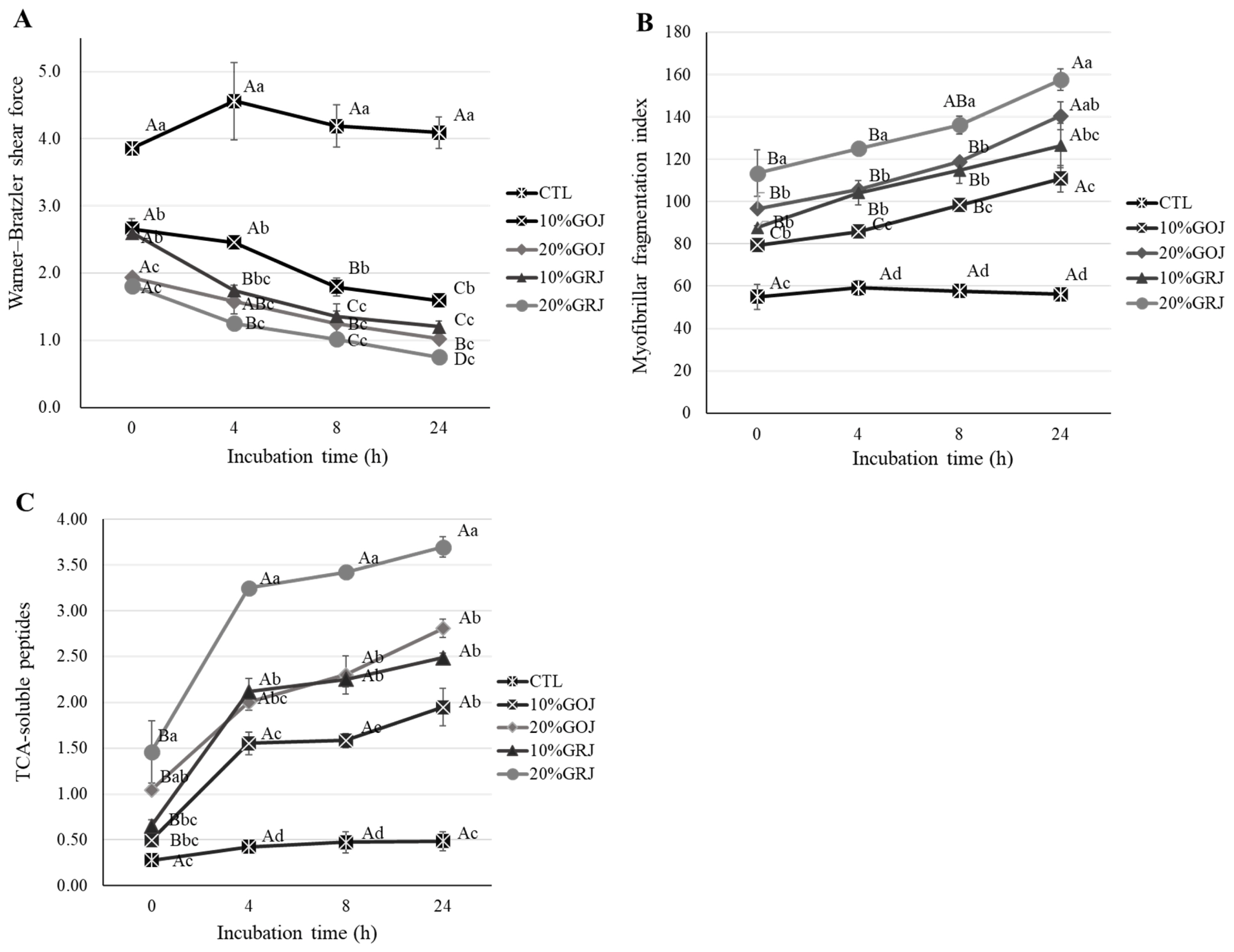1. Ahmad MN, Mat Noh NA, Abdullah EN, Yarmo MA, Mat Piah MB, Ku Bulat KH. Optimization of a protease extraction using a statistical approach for the production of an alternative meat tenderizer from Spondias cytherea roots. J Food Process Preserv 2019; 43:e14192
https://doi.org/10.1111/jfpp.14192

4. Zhu X, Kaur L, Staincliffe M, Boland M. Actinidin pretreatment and sous vide cooking of beef brisket: effects on meat microstructure, texture and in vitro protein digestibility. Meat Sci 2018; 145:256–65.
https://doi.org/10.1016/j.meatsci.2018.06.029


6. Ha M, Bekhit AEDA, Carne A, Hopkins DL. Characterisation of commercial papain, bromelain, actinidin and zingibain protease preparations and their activities toward meat proteins. Food Chem 2012; 134:95–105.
https://doi.org/10.1016/j.foodchem.2012.02.071

7. Gong X, Morton JD, Bhat ZF, Mason SL, Bekhit AEDA. Comparative efficacy of actinidin from green and gold kiwi fruit extract on in vitro simulated protein digestion of beef Semitendinosus and its myofibrillar protein fraction. Int J Food Sci Technol 2020; 55:742–50.
https://doi.org/10.1111/ijfs.14345

9. Zhang B, Sun Q, Liu HJ, Li SZ, Jiang ZQ. Characterization of actinidin from Chinese kiwifruit cultivars and its applications in meat tenderization and production of angiotensin I-converting enzyme (ACE) inhibitory peptides. LWT 2017; 78:1–7.
https://doi.org/10.1016/j.lwt.2016.12.012

10. Saiga AI, Tanabe S, Nishimura T. Antioxidant activity of peptides obtained from porcine myofibrillar proteins by protease treatment. J Agric Food Chem 2003; 51:3661–7.
https://doi.org/10.1021/jf021156g


11. Kaur L, Rutherfurd SM, Moughan PJ, Drummond L, Boland MJ. Actinidin enhances gastric protein digestion as assessed using an in vitro gastric digestion model. J Agric Food Chem 2010; 58:5068–73.
https://doi.org/10.1021/jf903332a


12. Rakasivi KGJ, Chin KB. Evaluation of product quality of chicken sausages with added cinnamon (Cinnamomum cassia) and mushroom (Pleurotus sajur-caju) powders at various concentrations. J Food Process Preserv 2022; 46:e16958
https://doi.org/10.1111/jfpp.16958

13. Wheeler TL, Shackelford SD, Koohmaraie M. Relationship of beef longissimus tenderness classes to tenderness of gluteus medius, semimembranosus, and biceps femoris. J Anim Sci 2000; 78:2856–61.
https://doi.org/10.2527/2000.78112856x


14. Culler RD, Parrish FC, Smith GC, Cross HR. Relationship of myofibril fragmentation index to certain chemical, physical and sensory characteristics of bovine longissimus muscle. J Food Sci 1978; 43:1177–80.
https://doi.org/10.1111/j.1365-2621.1978.tb15263.x

19. Chao D. Actinidin: the predominant protease in kiwifruit: a thesis presented in partial fulfilment of the requirements [dissertation]. Manawatu, New Zealand: Massey University; 2016.
20. Liu C, Xiong YL, Rentfrow GK. Kiwifruit protease extract injection reduces toughness of pork loin muscle induced by freeze–thaw abuse. LWT - Food Sci Technol 2011; 44:2026–31.
https://doi.org/10.1016/j.lwt.2011.05.019

21. McGhie TK, Ainge GD. Color in fruit of the genus Actinidia: carotenoid and chlorophyll compositions. J Agric Food Chem 2002; 50:117–21.
https://doi.org/10.1021/jf010677l


22. Leygonie C, Britz TJ, Hoffman LC. Oxidative stability of previously frozen ostrich Muscularis iliofibularis packaged under different modified atmospheric conditions. Int J Food Sci Technol 2011; 46:1171–8.
https://doi.org/10.1111/j.1365-2621.2011.02603.x

25. Bagheri Kakash S, Hojjatoleslamy M, Babaei G, Molavi H. Kinetic study of the effect of kiwi fruit actinidin on various proteins of chicken meat. Food Sci Technol 2019; 39:980–92.
https://doi.org/10.1590/fst.14118

29. Teh SS, Bekhit AEDA, Carne A, Birch J. Antioxidant and ACE-inhibitory activities of hemp (Cannabis sativa L.) protein hydrolysates produced by the proteases AFP, HT, Pro-G, actinidin and zingibain. Food Chem 2016; 203:199–206.
https://doi.org/10.1016/j.foodchem.2016.02.057


30. Yu D, Feng MQ, Sun J, Xu XL, Zhou GH. Protein degradation and peptide formation with antioxidant activity in pork protein extracts inoculated with Lactobacillus plantarum and Staphylococcus simulans. Meat Sci 2020; 160:107958
https://doi.org/10.1016/j.meatsci.2019.107958













 PDF Links
PDF Links PubReader
PubReader ePub Link
ePub Link Full text via DOI
Full text via DOI Download Citation
Download Citation Print
Print





